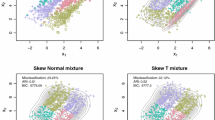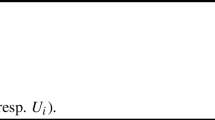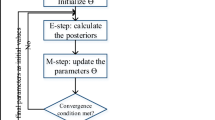Abstract
This paper deals with the problem of clustering dependent observations according to their underlying complex generating process. Di Lascio and Giannerini (Journal of Classification 29(1):50–75, 2012) introduced the CoClust, a clustering algorithm based on copula function that achieves the task but has a high computational burden. Moreover, the CoClust automatically allocates all the observations to the clusters; thus, it cannot discard potentially irrelevant observations. In this paper we introduce an improved version of the CoClust that both overcomes these issues and performs better in many respects. By means of a Monte Carlo study we investigate the features of the algorithm and show that it improves consistently with respect to the old CoClust. The validity of our proposal is also supported by applications to real data sets of human breast tumor samples for which the algorithm provides a meaningful biological interpretation. The new algorithm is implemented and made available through an updated version of the R package CoClust.


Similar content being viewed by others
References
Brechmann E, Schepsmeier U (2013) Modeling dependence with c- and d-vine copulas: the R package CDVine. J Stat Softw 52(3):1–27
Cherubini U, Luciano E, Vecchiato W (2004) Copula methods in finance. Wiley, Chichester
Clarke K (2007) A simple distribution-free test for non-nested model selection. Polit Anal 15:347–363
Di Lascio FML, Giannerini S (2012) A copula-based algorithm for discovering patterns of dependent observations. J Classif 29(1):50–75
Di Lascio FML, Giannerini S (2015) CoClust. R package version 0.3-1
Di Lascio FML, Giannerini S, Reale A (2015) Exploring copulas for the imputation of complex dependent data. Stat Methods Appl 24(1):159–175
Dortet-Bernadet JL, Wicker N (2008) Model-based clustering on the unit sphere with an illustration using gene expression profiles. Biostatistics 9(1):66–80
Eisen MB, Spellman PT, Brown PO, Botstein D (1998) Cluster analysis and display of genome-wide expression patterns. Proc Natl Acad Sci USA 95:14863–14868
Fraley C, Raftery A (1998) How many clusters? Which clustering method? Answers via model-based cluster analysis. Comput J 41(8):578–588
Hedenfalk I, Duggan D, Chen Y, Radmacher M, Bittner M, Simon R, Meltzer P, Gusterson B, Esteller M, kallioniemi OP, Wilfond B, Borg A, Dougherty E, Kononen J, Bubendorf L, Fehrle W, Pittaluga S, Gruvberger S, Loman N, Johannsson O, Olsson H, Sauter G (2001) Gene-expression profiles in hereditary breast cancer. N Engl J Med 344(8):539–548
Joe H, Xu J (1996) The estimation method of inference functions for margins for multivariate models. Technical Report 166, Department of Statistics, University of British Columbia
Nelsen RB (2006) Introduction to copulas. Springer, New York
Roverato A, Di Lascio FML (2011) Wilks’ \(\lambda \) dissimilarity measures for gene clustering: an approach based on the identification of transcription modules. Biometrics 67(4):1236–1248
Sklar A (1959) Fonctions de répartition à n dimensions et leurs marges. Publ Inst Stat Univ Paris 8:229–231
Tamayo P, Slonim D, Mesirov J, Zhu Q, Kitareewan S, Dmitrovsky E, Lander E, Golub T (1999) Interpreting patterns of gene expression with self-organizing maps: methods and application to hematopoietic differentiation. Proc Natl Acad Sci USA 96(6):2907–2912
Trivedi PK, Zimmer DM (2005) Copula modeling: an introduction for practitioners. Found Trends Econom 1:1–111
Vuong Q (1989) Likelihood ratio tests formodel selection and non-nested hypotheses. Econometrica 57:307–333
Yeung K, Fraley C, Murua A, Raftery A, Ruzzo W (2001) Model-based clustering and data transformations for gene expression data. Bioinformatics 17(10):977–987
Zimmer DM, Trivedi PK (2006) Using trivariate copulas to model sample selection and treatment effects: application to family health care demand. J Bus Econ Stat 24:63–76
Acknowledgments
F. Marta L. Di Lascio acknowledges the support of Free University of Bozen-Bolzano, Faculty of Economics and Management, via the project “Multivariate analysis techniques based on copula function”.
Author information
Authors and Affiliations
Corresponding author
Rights and permissions
About this article
Cite this article
Di Lascio, F.M.L., Giannerini, S. Clustering dependent observations with copula functions. Stat Papers 60, 35–51 (2019). https://doi.org/10.1007/s00362-016-0822-3
Received:
Revised:
Published:
Issue Date:
DOI: https://doi.org/10.1007/s00362-016-0822-3




